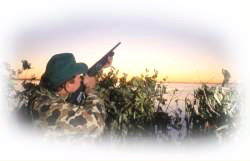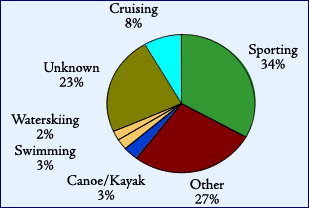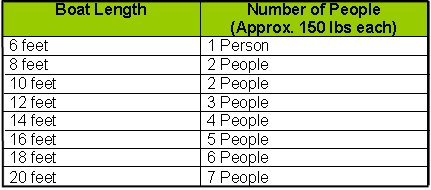Hunting & Fishing
Why Boating Eductaion for Hunters and Anglers is so Important
- One out of three people who died on the water died while fishing, hunting or on the way to fish and hunt.
- 47% of sportsmen did not even have a life jacket on board.
- 70% of hunters who died in boating accidents fell overboard as a result of their boat being improperly loaded, or due to moving around the boat unsafely.

According to the National Rifle Association, more hunters die each year from water-related accidents than from gunshot wounds. 91% of sportsmen who died in boating accidents between 1995-2000 were not wearing a life jacket. Compared with the general boating fatality population, sportsmen were far more likely to have not worn a life jacket than all other boaters - a difference that might have saved their lives.
Yearly Fatalities of Boaters
1995-2000

- 88% fatalities are from drowning.
- 40% of fatalities come from vessel capsizing.
- Cold water and strong current were reported in a high percentage of accidents.
- Most accidents happen in open motorboats 16 feet or less.
- Men ages 30-50 were the most common victims.
Special Issues
Most hunting and angling takes place on boats that are less than 16 feet long, the length of boat that has the dubious distinction of being involved in the lion’s share of boating fatalities. Boats under 16 feet often have flat bottoms or semi-v hulls and are known for their instability. It’s no surprise then that the primary causes of hunting and fishing accidents on the water are capsizing, falls overboard and flooding or swamping.
This isn’t to say hunters and anglers should stop using small boats. What it says is that they should take precautions in small boats, precautions like correctly loading the boat and using caution while moving about the boat and landing fish or fowl. Above all, a sportsman should wear his life jacket.
Loading the Boat
Correctly loading a small boat starts from your very first step onboard
- First of all, step gently into the center of boat; avoid stepping on the sides (called gunnels) or the seats, or jumping onboard.
- Secondly, if you have a lot of gear, hand the gear to someone on the boat, or leave it on the pier and reach for it from the boat. Boarding a boat with a handful of equipment gives you extra weight and instability, and leaves you without a hand to steady yourself.
- Also, it is important to hold on to something whenever boarding or moving around the boat, even if you feel you are stable. You never know when another boat’s wake, someone else in the boat losing their balance, or your dog’s sudden movement can cause a chain of events that might leave you in the water, or in the bottom of the boat with an injury.
When loading gear
- It is important to distribute the weight evenly around the boat, making sure not to overload. Take special care not to load too much in the back (stern), since once the boat picks up speed, the stern will go lower in the water and is prone to swamping.
- Additionally, it is important to keep the center of gravity low in the boat. Piling gear high can raise the center of gravity and can cause the boat to tip over unexpectedly. This same rule goes for the people in the boat, which is why you should avoid standing in small boats.
- Make sure your anchor and dock lines are properly stowed to avoid tripping.
- And as you are loading, be sure you have brought along a life jacket for each person aboard—it’s the law. Better yet, have everyone in your group put on the life jackets before even leaving the dock.
To avoid overloading the boat, check the vessel’s capacity plate
The capacity plate states the total amount of weight (including people, gear and motor) the boat is made to hold. If your boat does not have a capacity plate, the U.S. Coast Guard suggests the following basic guide.

Be sure to take into consideration the weight of the gear you’ve brought along.
To put this into perspective, if you have an 18 foot boat, you can expect to be able to carry 900 pounds of motor, gear, and people. If the outboard weighs 200 pounds, the fuel and gear weigh another 200 pounds, you can realistically only take 2 other people with you on the boat--maybe just one if everyone weighs over 200 pounds or the weather is rough.
Moving About the Boat
Once in the boat, it’s a good idea for all passengers to avoid standing. Small boats can easily become unstable, and when people and/or dogs are sharing the space, the danger of capsizing increases.
- The first thing to remember is just common sense: keep your weight in the center of the boat. If you’re reeling in a fish, try to do it in a seated position and use a landing net to get the fish into the boat. Hunters can also use a landing net or boat hook to avoid leaning too far over the side of the boat to retrieve birds and decoys.
- Hunters should stay seated while shooting so they can brace themselves for the gun’s recoil. Standing up in an unstable boat will raise the center of gravity and only make the boat less predictable.
- When setting decoys, be careful not to lean too far over the sides of the boat.
- Anglers should stay in a seated position during casting so as not to lose their balance. A jonboat is a good example of a boat that is not made for standing.
- Bass boats are specially designed and weighted for standing, just be sure to keep your legs spread for stability, lean against a seat where possible, and wear a life jacket.
- Landing Fish or Fowl is one of the most critical moments in your boat is when you try to retrieve your fish or waterfowl. Your blood is pumping, your heart is racing, and everyone in the boat is leaning over to see what you’ve got. That’s the moment that the weight of the boat can change suddenly, and before you know it, you’re all wet.

